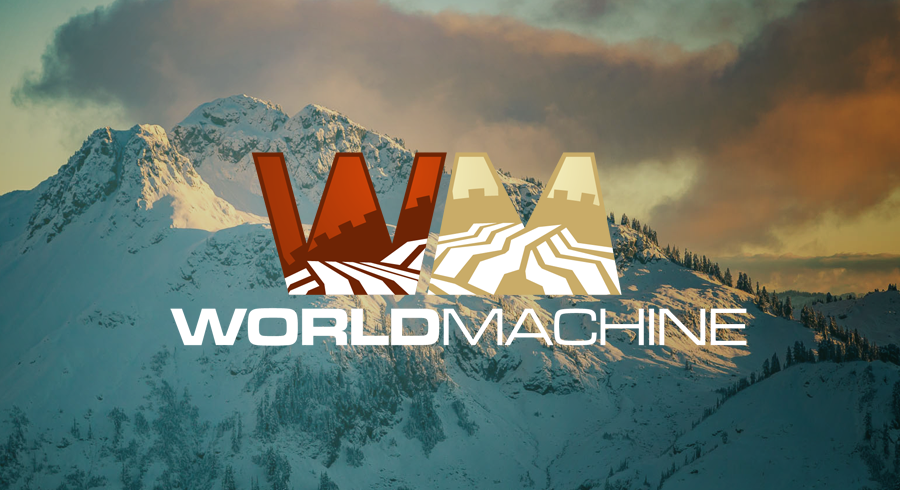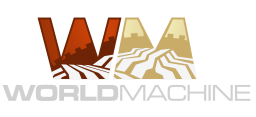
Artist Point is a major upgrade that brings Physically Based Rendering to World Machine.
Create PBR materials for your world from scratch, or by importing your existing PBR materials. Richly texture your world, and easily export it all in one click using glTF.
What’s New
Here’s a high-level overview of what’s new:
- View, export, and author PBR-based materials
- One-click scene export via glTF
- Create optimized meshes and tangent-space normals
- Over a dozen new powerful new devices such as Layers and Strata
- Make parameters vary across the map with the new spatially-varying parameters
You can get ‘Artist Point’ at the Update Center:
For more details, here is a fairly complete list of the changes in Artist Point:
Changelist
Major Features
These are significant features that you’ll notice right away opening the new version!
- Spatially-varying Parameters. Some device parameters can now be varied across the terrain by providing a heightfield, changing a single value into a range.
- New ‘curved’ device wiring for clean organization of networks
- Device overlays show you a heatmap of where memory, buildtime, or tiling issues are coming from in your world
- ‘Ribbon cable highlighting’ makes it easier to trace wires
- Universal generator placements – you can rotate any generator directly in its parameter dialog
- Added new memory conservation modes – Minimal, which removes data from unused ports only. High, which removes all data except from Outputs and Checkpoint data.
Viewport Changes
These changes relate to the viewports of World Machine. World Machine now uses physically based rendering to display your terrain.
- Configurable viewport lighting – select from menu, or right-click on lighting toggle in sidebar. Adjust colors, exposure, fog, etc. Includes lighting presets.
- New global toggles to display color/material
- Tile overlay guide
- Contour lines overlay guide, similar to a topo map.
- Physically based rendering used in 3D views
- Viewports now display water using an animating PBR water material
- Workview: When wiring/dragging onto a wire containing a composite type, WM will automatically prompt if you’d like to tap a specific channel
- Workview: When wiring/adding into a wire, the set of devices displayed into the quick add window are filtered by the wire’s datatype
- 2D View: now shows a list of channels when viewing a composite type (water, material, etc)
- Added ‘Copy Viewport Image’ command to quickly copy a screenshot of the active viewport to the clipboard.
- Added back mesh wireframe display
- Compositing devices like the Scatter and Layers device can now show partially-transparent results in the 3d viewports
- Device parameter view resizes to be larger when previously un-shown parameters appear
- Changed Scene Setup to not require a ctrl-drag on a render extent to move
Smaller Changes
Less-impactful changes that still improve your quality of life:
- Devices are presented more compactly by hiding their parameter inputs by default. Connect to a parameter by wiring to the device itself.
- Device parameter dialogs now remember their previous geometry when re-opening
- Reduced memory usage in complex networks, some minor speed improvements
- Build times are reported in ms as appropriate
- Device workview uses 8x MSAA for display quality
- New groups automatically get gentle coloration
- Added “visual editor” button for setting device origin
- Quick-add uses exclusive toggles now
- Added better error reporting for licensing issues, especially firewall connectivity problems
- Improved reporting of device datatypes throughout UI
- In toolbars or menus, the data type(s) that a device can process are now displayed in the tooltip.
- Added automatic cleanup of temporary files on next startup after a crash
- Improvements to the Project Upgrades dialog, letting you more easily inspect and update device to their latest versions.
- Added coloration/tooltips for extended parameters that support out-of-range values
Devices
Artist Point introduces many new devices related to manipulating color and materials. There are also some major changes and new modes added to existing ones.
Material and Texture Devices
- Layers (New) – This is an extremely useful new tool that lets you blend together many inputs in one place with a Photoshop-style layer interface, instead of chaining Choosers. Advanced features such as Heightblend modes, partial-layers.
- Material (New) – Define a PBR material. Can load maps from disk or create from input maps.
- Material Output (New) – Output all channels of a PBR texture with a single device.
- Levels (New) – Similar to Photoshop tool, adjust domain, range, midtones of heights or colors
- Tint (New) – Adjust an input so that it averages to the given color. Quite powerful color adjustment tool!.
- Crop/Transform (New) – Take a section of an existing packet as a new packet. Can transform/repeat boundaries
- Adjust Color (New) – Colorize and adjust hue/sat/bright
- Normals Combiner (New). Properly combine two normal maps by doing the necessary vector rotations to produce accurate results.
- Create Normals – Supports tangent space normal maps, and has a convenient OpenGL/DX toggle
- Instance Tiling – Gains support for Materials and new ‘Random Tile’ mode
- Instance Scatter – Gains support for Materials, Variations of Size/Rotation/Opacity
- Channel Split/Combine – New support for LAB & HCL channels
- Splatmap/Weightmap device can now optionally export a RGBA splatmap directly, rather than forcing you to jump through hoops.
- Meshify (New) – Converts heightfield to Mesh for later export. Supports highly optimized mesh generation and automatically creates a tangentspace normalmap for the mesh.
- Scene Output (New) – Export an entire scene via the glTF format (possibly other formats in the future)
- Masked View (New) – View any texture or heightfield with an alpha cutout applied to it
Other New Devices
- Strata (New) – very powerful new device; Etch strata detail using horizontal displacements into the terrain. Also produces addt’l masks for the strata
- Crystallize (new) – Create columns taking their height from the input. Supports square/hex shapes
- Checkpoint – Caches data in new memory conservation mode, automatic-expanding port connections
- Colorizer – Added perceptual HSL sliders, albedo report
- Snow – added new simple mask output
- Equalizer – Supports RGB, new Distribution parameter lets you set to Uniform, Gaussian, Log-Normal, or Exponential distributions. Very very useful!
- Combiner – 3 new RGB-only blending modes, soft min/max, a useful “invert 2nd input” checkbox.
- Clamp – gains a Histogram report
- Basic Noise – New version supports solid noise, spatial params
- Voronoi – New version with solid noise input, ‘Crystallize’ mode
- Gradient – New tiling mode, curve variable inputs for height/width, spatial params
- Radial Gradient – New types, ‘repeating’ checkbox
- Spatial parameters added to various devices in smaller ways
- Tap – Replace or extract an individual channel from a composite datatype
- Report Color/Height/Extents – Analyze an input and extract valuable information such as the average color, minimum height, etc
- Library Output gains automatic expanding port connections
- Re-added “track viewport lighting” to Lighting Generator (renamed Bake Lighting). If this is enabled, adjusting viewport lighting will trigger a history entry and the lighting information in the generator will be updated.
- Scene View – Added Shadowmap input. Feed it a shadow-only output from the lighting generator to have raytraced shadows in your viewport
- Various selection/compositing devices (Selectors, Scatter, Layers) show partially-masked output as such
You can download this version at the Update Center if your maintenance is live through 1/2022:

Start the discussion at forum.world-machine.com